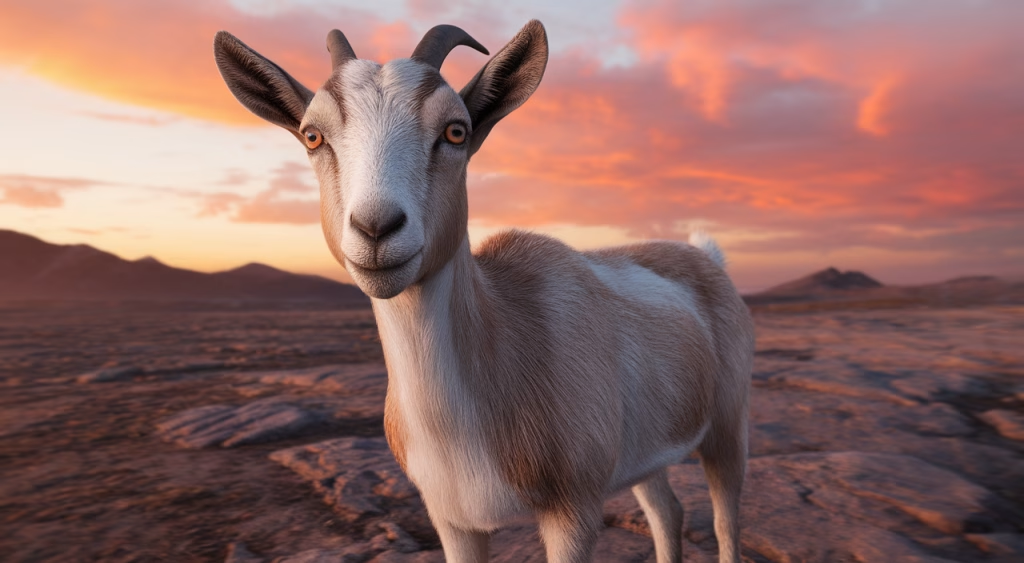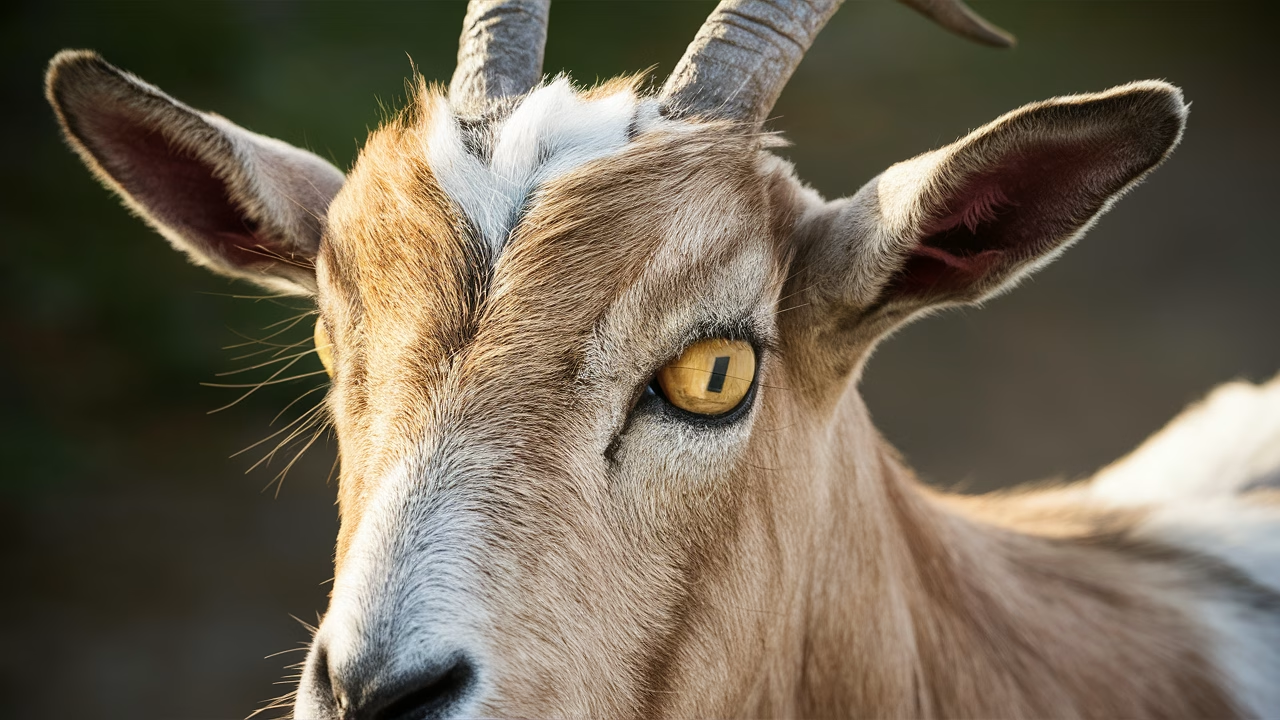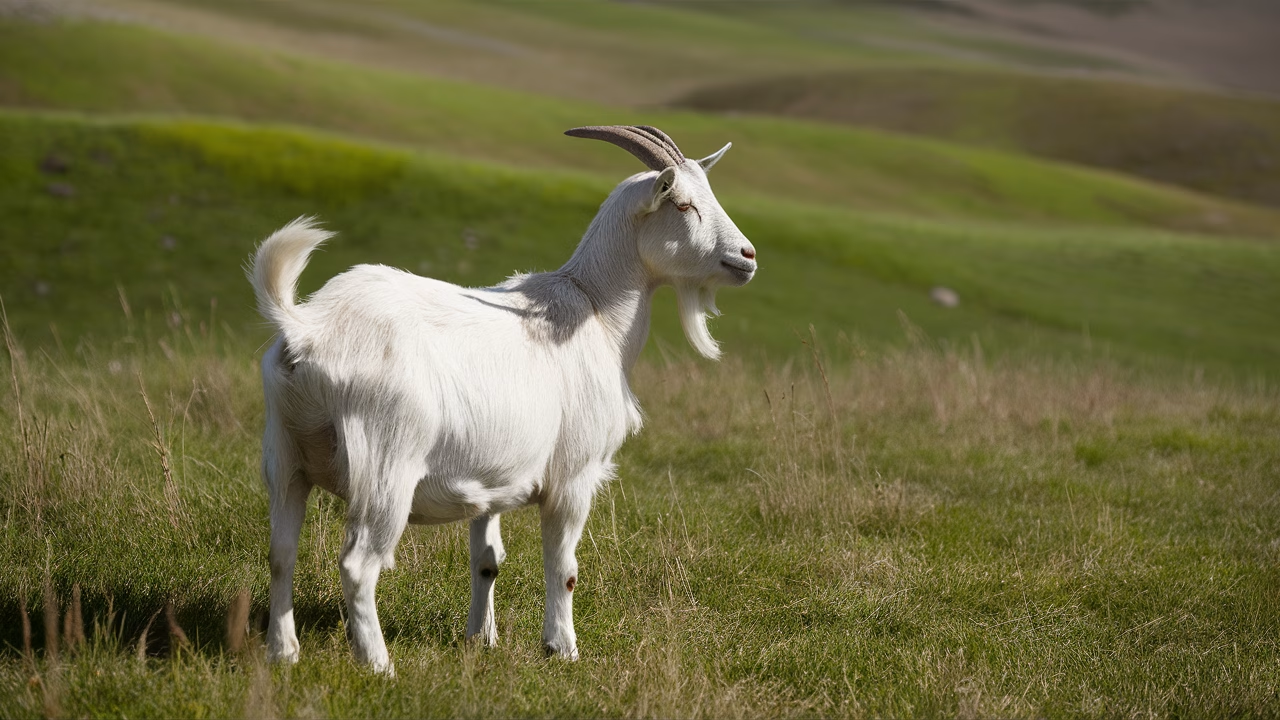Why do goats have rectangular pupils?
Goats have rectangular pupils to maximize their peripheral vision and enhance their survival as prey animals. This unique horizontal, rectangular pupil shape dramatically expands their field of view, allowing them to detect predators from nearly 340 degrees around them while navigating challenging terrain with confidence. The rectangular design minimizes visual distortion and keeps the horizon in sharp focus, which is critical for prey animals that must constantly monitor their surroundings for threats.
TL;DR: The Power of Rectangular Pupils in Goat Vision
- Natural Defense System: Goats’ rectangular pupils give them a panoramic horizontal view—perfect for early predator detection.
- Stability on Slopes: The horizontal pupil shape stays aligned with the ground, aiding navigation on rocky landscapes.
- Scientific Insight: As prey animals, goats evolved this trait along with other ungulates to defend themselves better in open environments.
- Fun Fact: Goats can rotate their eyes to maintain alignment with the horizon—even when they move their head!
Understanding Goat Vision
A. The Unique Anatomy of Goat Eyes
When you look into a goat’s eyes, you’re immediately struck by a gaze quite unlike any other in the animal kingdom. Instead of the round pupils you see in humans or vertical slits found in cats, goats possess wide, horizontal, rectangular pupils. These distinctive goat pupils are part of a sophisticated visual system that supports their status as expert grazers and agile climbers.
The goat eye anatomy features horizontally elongated rectangular pupils positioned in laterally placed eyes, meaning their eyes sit more on the sides of their head rather than facing forward. This arrangement allows goats to view nearly 320 to 340 degrees around them without moving their heads. The elongated goat pupil shape filters light horizontally and increases visual clarity across a wide plane, especially beneficial in open fields or mountainous terrain where goat eyesight truly shines.
Even more remarkable, goats can rotate their eyes within their sockets to ensure their rectangular pupils stay perfectly aligned with the horizon, even when they tilt their heads while climbing or grazing. This extraordinary adaptation places goats among an elite group of animals with horizontal pupils, including sheep and deer.
B. How Rectangular Pupils Enhance Peripheral Vision
The horizontal pupil shape serves a vital purpose in dramatically improving peripheral vision. Picture yourself as a goat standing in a meadow—you need to continuously scan for predators like hawks above or wolves approaching from any direction. Thanks to their remarkable rectangular pupils, goats accomplish this surveillance without needing to turn their heads constantly.
This optical adaptation spreads the goat’s visual focus along the horizontal plane while limiting excessive light from above and below. This helps maintain balanced brightness and improves contrast detection near the ground level, which proves especially valuable in uneven terrains where accurate footing can mean the difference between safety and danger.
In practical terms, this means a goat grazing on a steep hillside can simultaneously monitor for potential threats and maintain excellent coordination to avoid dangerous missteps, all without interrupting their feeding behavior.
The Science Behind Rectangular Pupils
A. Evolutionary Advantage of Horizontal Pupils
You might wonder why goats evolved horizontal pupils instead of vertical ones like cats. The answer lies in their evolutionary roles and survival needs. Vertical pupils are primarily found in nocturnal predators like domestic cats or foxes, where they enable precise depth perception crucial for pouncing on prey. In contrast, horizontal pupils in animals like goats are perfectly suited to prey species that require an exceptionally wide field of view to detect danger from multiple directions.
As herbivorous prey animals, goats fall squarely into this category. Scientific research demonstrates that this broad field of view provides these animals with just enough visual advantage to spot threatening movement early and react quickly, often gaining precious seconds before predators can strike. Their rectangular pupils thus became a naturally selected trait that significantly improved their survival rates.
| Animal | Pupil Shape | Pupil Function |
|---|---|---|
| Goat | Horizontal Rectangular | Panoramic view, terrain awareness |
| Cat | Vertical Slit | Hunting accuracy, night focus |
| Horse | Horizontal | Wide field for predator detection |
| Eagle | Round | Sharp central focus for hunting |
B. Comparing Goat Vision to Other Animals
When we compare goat eyesight to other animals, we discover fascinating differences in visual capabilities. While goats don’t possess the razor-sharp depth perception of predators, they excel in panoramic tracking and motion detection. Their animal vision isn’t designed for recognizing fine details or distinguishing colors, but rather for spotting movement patterns and navigating complex terrain.
Goats share similar horizontal pupils in animals like sheep and deer, but their climbing lifestyle sets them apart. Unlike sheep that typically graze in relatively flat pastures, mountain goats and their relatives must maintain visual stability while navigating steep, rocky terrain. This makes their rectangular pupils and horizon-aligned eye rotation abilities even more impressive and essential for survival.
Interestingly, some aquatic animals like cuttlefish have developed W-shaped pupils for enhanced underwater contrast, but their visual field remains limited by water clarity and depth—a constraint that land-dwelling goats never face.
Real-Life Applications of Goat Vision
A. How Farmers Benefit from Goats’ Visual Capabilities
Understanding the remarkable capabilities of goat eyesight extends far beyond academic interest—it offers practical benefits for farmers, herders, and anyone working with these animals. Recognizing that goats can detect potential threats and environmental changes before reacting provides valuable insights into herd management, pasture planning, and behavioral monitoring.
Experienced farmers often observe that goats are among the first animals to react when something unusual occurs in their environment. This isn’t just keen intuition—it’s their sophisticated rectangular pupils and peripheral vision working as nature intended. Their ability to detect subtle movements and changes long before humans or other livestock makes them excellent early warning systems for the entire farm.
Additionally, goats instinctively position themselves with their backs against solid objects like fences or walls when resting. This behavior maximizes their rectangular pupils’ effectiveness by providing a complete visual sweep of potential approach routes, helping farmers understand optimal shelter placement and grazing rotation strategies.
B. Fun Facts about Goat Eyesight
Here are some fascinating facts about goat vision that showcase the incredible capabilities of their rectangular pupils:
- Eye Rotation Masters: Goats can rotate their eyes nearly 50 degrees to keep their rectangular pupils perfectly level with the ground, even during steep climbs.
- Twilight Specialists: Their pupils adjust rapidly to changing light conditions, significantly improving their vision during dawn and dusk when many predators are most active.
- Nearly 360° Vision: Thanks to their laterally positioned eyes and rectangular pupil shape, most goats can see behind themselves without turning their heads.
- Stress-Resistant Vision: Unlike many mammals that experience tunnel vision under stress, goats maintain their full panoramic field of view even in threatening situations.
Final Thoughts: The Wonders Hidden in a Goat’s Eyes
The rectangular pupils of goats represent far more than an interesting biological curiosity—they showcase a perfect example of evolutionary adaptation where form follows function. This remarkable structural feature enables goats to survive, thrive, and navigate gracefully through sometimes dangerous environments while maintaining their essential grazing behaviors.
Whether you’re observing goats in a peaceful barnyard or watching them scale seemingly impossible rocky peaks, their distinctive eyes offer a masterclass in survival adaptation. As a zoologist, I consistently remind students that some of life’s most profound lessons in evolutionary success come from quietly observing the creatures staring back at us with their uniquely designed rectangular pupils.
Frequently Asked Questions
- How do rectangular pupils improve goat vision?
- They enhance horizontal field of view and visual clarity across uneven terrain, helping goats detect predators and navigate slopes with precision.
- Can goats see in the dark?
- While they aren’t nocturnal, goats have decent dusk and dawn vision due to adaptive pupil dilation, making them more effective in low light than humans.
- Do other animals have rectangular pupils?
- Yes. Sheep, deer, and some species of antelope display similar pupil structures for many of the same survival advantages.
- Are goat pupils always horizontal?
- Yes, and goats can rotate their eyes within the socket to keep them aligned with the ground—even when their head tilts.
- What type of vision do goats lack?
- Goats generally have limited color vision and depth perception compared to humans or predators. Their visual strength lies in widescale motion detection, not detail.
- Why do goat eyes look so unusual to humans?
- Human pupils are round, so when we see horizontal slits, it’s visually unsettling. But this shape serves a clear purpose in nature—wide perception.
- Are rectangular pupils genetically determined?
- Yes, this feature is genetically ingrained and shared among several ungulate species as a result of evolutionary adaptation.





